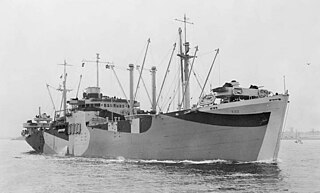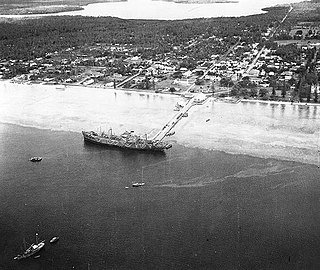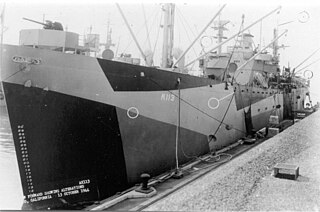
USS Achernar (AKA-53) was an Andromeda-class attack cargo ship of the United States Navy during World War II and after.

The USS Albireo (AK-90) was a Crater-class cargo ship in the service of the US Navy in World War II and manned by a US Coast Guard crew. She was the only ship of the Navy to have borne this name. She is named after Albireo, a star in the constellation of Cygnus.

USS Grumium (AK-112/IX-174/AVS-3) was a Crater-class cargo ship and aviation supply ship in the service of the US Navy in World War II. Named after the star Grumium in the constellation Draco, it was the only ship of the Navy to bear this name.

USS Fomalhaut (AK-22/AKA-5/AE-20) was a Fomalhaut class attack cargo ship named after Fomalhaut, a star in the southern constellation Piscis Austrinus. She served as a commissioned ship for 4 years and 3 months.

USS Betelgeuse (AK-28/AKA-11) was an Arcturus-class attack cargo ship, the first United States Navy ship named for Betelgeuse, a star in the constellation Orion. She served as a commissioned ship for 4 years and 9 months.

USS Ottawa (AKA-101) was a Tolland-class attack cargo ship in service with the United States Navy from 1945 to 1947. She was sold into commercial service and was lost in 1951.

USS Sheliak (AKA-62) was an Andromeda-class attack cargo ship in service with the United States Navy from 1944 to 1946. In 1948, she was sold into commercial service and was scrapped in 1969.

USS Cepheus (AKA-18) was an Andromeda-class attack cargo ship of the United States Navy that was manned by United States Coast Guard. She was in service from 1943 to 1946 and was subsequently sold into commercial service. She ran aground on a reef and became a constructive total loss in 1968.

USS Andromeda (AKA-15) was an Andromeda-class attack cargo ship in service with the United States Navy from 1943 to 1956. She was scrapped in 1971.

USS Sherburne (APA-205) was a US Navy Haskell-class attack transport, built and used during World War II. She was of the VC2-S-AP5 Victory ship design type. Sherburne was named for Sherburne County, Minnesota. She was later converted and renamed USS Range Sentinel (AGM-22), a missile range instrumentation ship.

USS Algorab (AKA-8) was laid down as Mormacwren, one of the earliest Maritime Commission-type C2 ships, on 10 August 1938 by the Sun Shipbuilding & Drydock Co., Chester, Pennsylvania as hull 177 for Moore-McCormack. Mormacwren was acquired by the United States Navy 6 June 1941, commissioned 15 June 1941 as USS Algorab (AK-25) and was redesignated an attack transport on 1 February 1943 with the hull number chanted to AKA-8. Algorab decommissioned on 3 December 1945 and was delivered to the Maritime Commission on 30 June 1946 for disposal, purchased by Wallem & Co. on 4 April 1947 for commercial service.

USS Alcyone (AKA-7) was an Arcturus-class attack cargo ship named after Alcyone, the brightest star in the star cluster Pleiades. She served as a commissioned ship for five years and one month.

USS Electra (AKA-4) was an Arcturus-class attack cargo ship named after Electra, a star in the Pleiades star cluster in the constellation Taurus. She served as a commissioned ship for seven years.

USS Rutilicus (AK-113) was a Crater-class cargo ship commissioned by the US Navy for service in World War II. She was responsible for delivering troops, goods and equipment to locations in the Asiatic-Pacific Theater.

USS Azimech (AK-124) was a Crater-class cargo ship commissioned by the US Navy for service in World War II, named after the Azimech, the other name of Spica, the brightest star in constellation Virgo. She was responsible for delivering troops, goods and equipment to locations in the war zone.

USS Lesuth (AK-125) was a Crater-class cargo ship commissioned by the US Navy for service in World War II. Lesuth was named after the star Lesuth in the constellation Scorpius. She was responsible for delivering troops, goods and equipment to locations in the Asiatic-Pacific Theater.
USS Syrma (AK-134) was a Crater-class cargo ship commissioned by the U.S. Navy for service in World War II. She was responsible for delivering troops, goods and equipment to locations in the war zone.

USS Ara (AK-136) was a Crater-class cargo ship commissioned by the US Navy for service in World War II. Ara is named after the constellation Ara. She was responsible for delivering troops, goods and equipment to locations in the Asiatic-Pacific Theater.

USS Livingston (AP-163/AK-222) was a Crater-class cargo ship built for the US Navy during World War II. She was responsible for delivering troops, goods and equipment to locations in the Asiatic-Pacific Theater.

USS Arcturus (AK-18/AKA-1) was an Arcturus-class attack cargo ship named after Arcturus, a star in the constellation Boötes. She served as a commissioned ship for 5 years and 5 months.



















